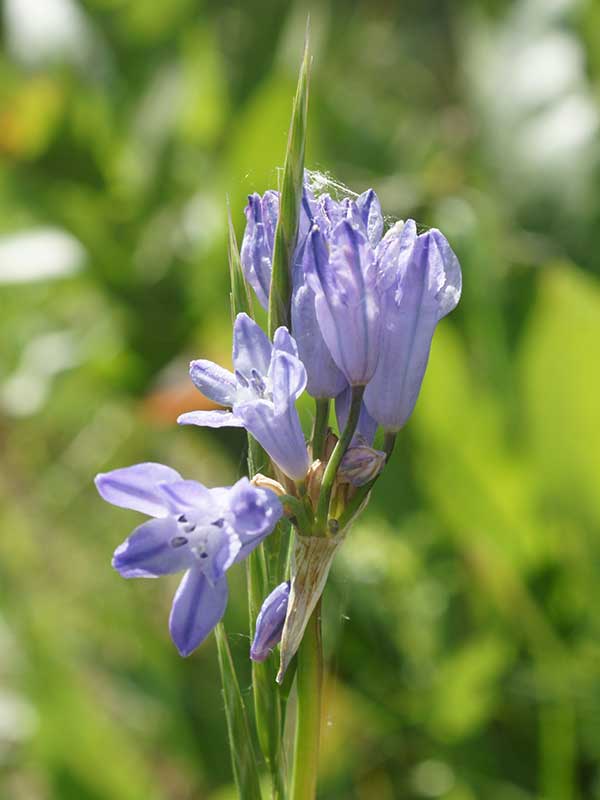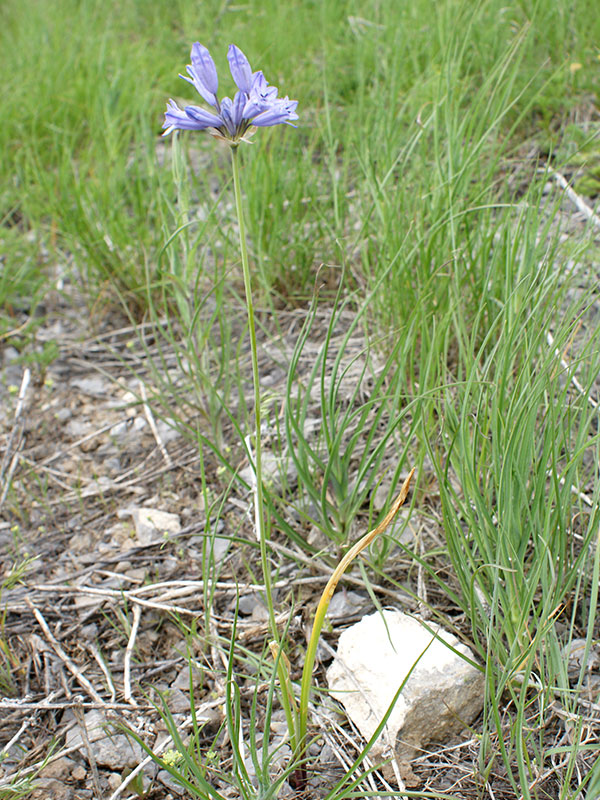Triteleia grandiflora / wild hyacinth
- terminal cluster of several, blue (to white) funnel-shaped flowers
- 6 tepals, 3 of which look wrinkled; deep blue lines on each tepal
- only 2-3 very long thin basal leaves
- onion-like but not smelly
- mostly in grasslands – late June, early July
Synonym: Brodiaea douglasii, Brodiaea grandiflora
Also known as: large-flowered triteleia, large-flowered triplet lily
Triteleia grandiflora is one of those lilies whose classification has been problematic and changing frequently. In addition to being in the family Liliaceae, it has also been included in the Asparagaceae, Melanthiaceae, and Themidaceae. As of 2019, it seems to be in the Asparagaceae.
More importantly, if you are trying to identify this wildflower, the wild hyacinth has just two or three long (ca. 2.5 feet) and very narrow basal leaves, and a single flowering stem with an umbel-like cluster of flowers.
The flowers are funnel-shaped (when open) and each has its own pedicel, up to an inch or so long. Before they open, the flowers look somewhat like gentians. The funnel is made of 6 “petals”, technically tepals, the inner of which look ruffled, as though someone didn’t pull them out of the drier soon enough. The flowers range from deep blue to white, with a darker blue mid-vein. There are 6 stamens, which is why (they say) that they are no longer Brodiaea spp, since they only have 3 stamens.
The wild hyacinth is sometimes mistaken for an onion, but has no detectable aroma, and that is a useful field mark.
T. grandiflora is found mostly in grasslands but also in sagebrush, woodlands and forests. It blooms in spring through early summer, i.e. late May to early July in the Valley.
Wild hyacinth is a perennial growing from a corm. While it seems that the life history strategy of this plant is not well understood, the corm appears to be quite important, ensuring survival during dormancy and through periods of environmental stress. And that is where it gets particularly interesting. Individual T. grandiflora plants may be either diploid or polyploid. Polyploidy has been associated, broadly in plants, with greater vigor, and greater adaptability to different environments. Stresses of many sorts seem to affect diploids more severely than polyploids. In this case, reproduction by seed is better if the mom is polyploid as is clonal reproduction by division of the corms.
Finally, although this species seems to be doing fine in the Valley and the Targhee National Forest in general, this is not the case everywhere. It is, for example, imperiled in Colorado and Wyoming generally. It has also been listed as “a candidate for sensitive species designation” in the greater Yellowstone ecosystem, but without action to date. With the global decline in pollinator insect species, things could change (for the worse). Wild hyacinth is primarily a cross-pollinating species… thus dependent on the health and welfare of pollinator populations.
More information on conservation status and localities is available here.
| Color | |
|---|---|
| Family | |
| Blossom size | |
| Inflorescence size | |
| Inflorescence type | |
| When? | |
| Where? |










